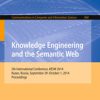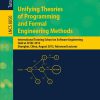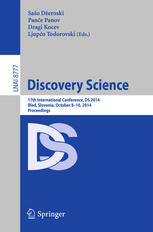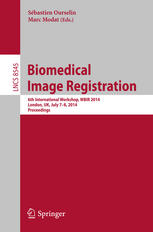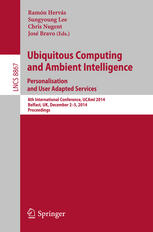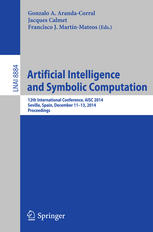Multi disciplinary Trends in Artificial Intelligence 1st Edition by Narasimha Murty,Xiangjian He,Paul Weng,Raghavendra Rao Chillarige 3319133640 9783319133645
$50.00 Original price was: $50.00.$25.00Current price is: $25.00.
Multi disciplinary Trends in Artificial Intelligence 1st Edition by Narasimha Murty,Xiangjian He,Paul Weng,Raghavendra Rao Chillarige – Ebook PDF Instant Download/Delivery:9783319133645,3319133640
Full download Multi disciplinary Trends in Artificial Intelligence 1st Edition after payment
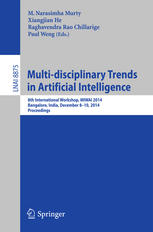
Product details:
ISBN 10:3319133640
ISBN 13:9783319133645
Author:Narasimha Murty,Xiangjian He,Paul Weng,Raghavendra Rao Chillarige
This book constitutes the refereed conference proceedings of the 8th International Conference on Multi-disciplinary Trends in Artificial Intelligence, MIWAI 2014, held in Bangalore, India, in December 2014. The 22 revised full papers were carefully reviewed and selected from 44 submissions. The papers feature a wide range of topics covering both theory, methods and tools as well as their diverse applications in numerous domains.
Multi disciplinary Trends in Artificial Intelligence 1st Table of contents:
1 Introduction
2 Sequence Generating Algorithm (SGA)
3 Potential Interval Qualifier Algorithm (PIQA)
4 Illustration for SGA and PIQA
5 Numerical Experiments
6 Conclusion
References
Stochastic Leaky Integrator Model for Interval Timing
1 Introduction
2 Spiking Neural Networks
2.1 Spiking Neuron Models
3 The Model
4 Results and Discussion
5 Conclusion and Future Work
References
Multi-objective Exploration for Compiler Optimizations and Parameters
1 Introduction
2 Compiler Optimization Space
3 Multi-objective Exploration Framework
3.1 Experimental Setup
3.2 GA Based Optimization Option Selection and Parameter Set Tuning
3.3 Fitness Function
3.4 Issues Faced during GA Framework
4 Analysis of the Results
5 Summary and Future Work
References
Association Rule Mining via Evolutionary Multi-objective Optimization
1 Introduction
2 Various Optimization Based Techniques
2.1 Firefly Optimization Algorithm (FFO)
2.2 Threshold Acceptance Algorithm (TA)
2.3 Binary Firefly Optimization (MO-BFFO)
3 Multi-objective Association Rule Miners
3.1 Preprocessing
3.2 Rule Representation
3.3 Quality Measures
3.4 Steps Involved in MO-BPSO
3.5 Steps Involved in MO-BFFO-TA
3.6 Steps Involved in MO-BPSO-TA
4 Results and Discussion
5 Conclusion
References
Distance-Based Heuristic in Selecting a DC Charging Station for Electric Vehicles
1 Introduction
2 Related Work
3 DC Charging Station Selection
4 Performance Measurement
5 Conclusions
References
Automated Reasoning in Deontic Logic
1 Introduction
2 Deontic Logic as Modal Logic KD
3 Automated Reasoning for Deontic Logic
3.1 Transformation from Deontic Logic into ALC
3.2 Translation from ALC into DL-Clauses
3.3 Reasoning Tasks
4 Applications
4.1 Contrary-to-duty Obligations
4.2 An Example from Multi-agent Systems
4.3 Experiments
5 Conclusion
References
Image Processing Tool for FAE Cloud Dynamics
1 Introduction
2 Overview of FAE System and FAE Experimental Set Up
2.1 Overview of FAE System
2.2 FAE Experimental Set Up
3 Cloud Dynamics: Image Processing Tools (CDIPT)
3.1 Frame Extraction from the Video
3.2 Cloud ROI Extraction
3.3 Representing the Cloud ROI by MBR
3.4 Radius and Height Determination Process
4 Implementation
5 Demonstration and Validation
5.1 Validation of the Model with the Experimental Data of HEMRL (4.2 kg FAE)
6 Conclusion
References
N-gram Based Approach for Opinion Mining of Punjabi Text
1 Introduction
2 Approach Used
2.1 Stemming
2.2 Negation Handling Process
2.3 N-grams
2.4 Feature Set
2.5 Corpus Generation
3 Methodology
4 Result Evaluation
5 Conclusion and Future Work
References
Application of Game-Theoretic Rough Sets in Recommender Systems
1 Introduction
2 Overview of Game-Theoretic Rough Set Model
3 Applying GTRS in Collaborative Recommendations
3.1 Properties of Accuracy and Generality of Recommendations
3.2 An Approach for Effective Recommendations with GTRS
3.3 Repetitive Threshold Learning with GTRS
4 Experimental Results and Discussion
5 Conclusion
References
RGB – Based Color Texture Image Classification Using Anisotropic Diffusion and LDBP
1 Introduction
2 Anisotropic Diffusion
3 Local Directional Binary Patterns (LDBP)
4 The Proposed Method for Texture Image Classification
4.1 Texture Training Module
4.2 Texture Classification
5 Experimental Results and Discussion
6 Conclusion
References
Knowledge-Based Design for Structural Analysis of Printed Mathematical Expressions
1 Introduction
2 Related Work
2.1 Intermediate Representation
2.2 Structure Generation
3 Proposed Design to ME Structural Analysis
4 ME Tree Structure and Its Generation
4.1 Tree Representation
4.2 Logical Proof for Completeness
4.3 Spatial Efficiency and Generality
4.4 Algorithm to Generate ME Tree
5 Structure Validation
6 Experimental Results and Discussion
7 Conclusions and Future Directions
References
A New Preprocessor to Fuzzy c-Means Algorithm
1 Introduction
2 Related Work
3 Fuzzy c Means
4 New Preprocessor to Fuzzy c-Means Algorithm
4.1 Fuzzy Min-Max Neural Network
4.2 Fuzzy Min-Max Clustering Algorithm
4.3 Fuzzy Min-Max Preprocesser for Fuzzy c-Means
5 Experiments and Results
5.1 Experimental Design
5.2 Results
5.3 Analysis
6 Conclusion
References
Domain Specific Sentiment Dictionary for Opinion Mining of Vietnamese Text
1 Introduction
2 Related Work
3 Dictionary-Based Approach
4 Building Domain Specific Sentiment Dictionary
4.1 Step 1: Building Vietnamese Sentiment Dictionary
4.2 Step 2: Enriching Vietnamese Sentiment Dictionary with Domain Specific Sentiment Words
5 Using Domain Specific Sentiment Dictionary for Opinion Mining
5.1 Word Analysis
5.2 Phrase Analysis
6 Experiments
6.1 Data Pre-processing
6.2 Experimental Results
7 Conclusion
References
Support Vector–Quantile Regression Random Forest Hybrid for Regression Problems
1 Introduction
2 Literature Review
3 Intelligent Techniques Overview
3.1 Support Vector Machine
3.2 Decision Trees
3.3 Classification and Regression Tree (CART)
3.4 Quantile Regression
3.5 Random Forest
3.6 Quantile Regression Random Forest
3.7 DEWNN
3.8 Group Method of Data Handling (GMDH)
3.9 Kernel GMDH
4 Proposed Hybrid, Experiment setup and Dataset Description
4.1 Proposed Hybrid
4.2 Research Methodology
4.3 Data Set Description
5 Results and Discussion
6 Conclusion
References
Clustering Web Services on Frequent Output Parameters for I/O Based Service Search
1 Introduction
2 Clustering Services on Frequent Service Output Parameter Patterns
2.1 Definitions
2.2 Frequent Service Output Parameter Pattern Based Clustering
2.3 Accelerating Parameter Based Service Search
3 Experimental Results
3.1 Performance Analysis
3.2 Performance Improvement Obtained in Output Parameter Based Service Search
4 Related Work
5 Conclusion
References
IntelliNavi : Navigation for Blind Based on Kinect and Machine Learning
1 Introduction
2 Related Work
3 ProposedSystem-
3.1 System Architecture
4 Implementation and Experimental Results
4.1 RGB-D Object Dataset
4.2 System Integration and Testing
5 Conclusion and Future Works
References
A Trust Metric for Online Virtual Teams and Work Groups
1 Introduction
1.1 Trust
1.2 Recommender Trust
1.3 Direct Trust Computation
1.4 Indirect Trust Computation
1.5 Recommender Trust Computation
2 Conclusion
References
Web Service Composition Using Service Maps
1 Introduction
2 Related Work
3 SMap for Specification and Composition
3.1 SMap Specification and Its Extension
3.2 Querying SMaps – A Composition Perspective
4 Service Composition : A Process
4.1 Identifying Service Maps
4.2 Composability of SMaps
4.3 Service Composition and Ranking
5 Framework for SMap Composition Extending Juddi
6 Conclusion
References
Integrated Representation of Spatial Topological and Size Relations for the Semantic Web
1 Introduction
2 Background and RelatedWork
3 Spatial Representation
3.1 Decomposition of RCC-QS Relations
4 Spatial Reasoning
4.1 RCC5-QS Reasoning Using Decomposition
4.2 Reasoning over Integrated RCC-5 and Size Relations
5 Reasoning over RCC-8 Topologic and Size Relations
6 Evaluation
6.1 Experimental Evaluation
7 Conclusions and Future Work
References
Using Bayesian Networks to Model and Analyze Software Product Line Feature Model
1 Introduction
2 Feature Diagram and Bayesian Network
3 Feature Modeling Analysis Rules
4 Analysis Rules in BN
5 Conclusion
References
A Content-Based Approach for User Profile Modeling and Matching on Social Networks
1 Introduction
2 Preliminaries
2.1 Pretopology Concepts
2.2 LDA Topic Model
2.3 Collapsed Gibb Sampling
2.4 Vietnamese Text Processing
3 Content-Based Profiling and Matching
3.1 Building User Profiles
3.2 Matching Strategy
3.3 Generating Subsets of Similar Users
4 Experiment Results
5 Conclusion
People also search for Multi disciplinary Trends in Artificial Intelligence 1st:
discussion paper artificial intelligence in drug manufacturing
a multidisciplinary team consists of
what is the new trends of artificial intelligence
future trends in artificial intelligence and machine learning
is multidisciplinary the same as interdisciplinary
Tags:
Narasimha Murty,Xiangjian He,Paul Weng,Raghavendra Rao Chillarige,Intelligence,disciplinary
You may also like…
Computers - Computer Science
Computers - Computer Science
Computers - Computer Science
Computers - Computer Science
Computers - Computer Science
Computers - Computer Science
Computers - Computer Science


